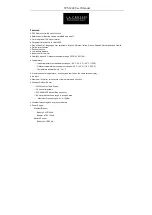
15
Page
Version 1.3 October 2020
Best Practices for Wireless Communication
Wireless communication is susceptible to interference, distance, walls and metal barriers. We recommend the
following best practices for trouble free wireless communication.
1.
Electro-Magnetic Interference (EMI)
. Keep the sensors several feet away from computer monitors
and TVs.
2.
Radio Frequency Interference (RFI).
If you have other 433 MHz devices and communication is
intermittent, try turning off these other devices for troubleshooting purposes. You may need to relocate
the transmitters or receivers to avoid intermittent communication.
3.
Line of Sight Rating.
This device is rated at 100 m line of sight (no interference, barriers or walls) but
typically you will get 30 m maximum under most real-world installations, which include passing
through barriers or walls.
4.
Metal Barriers.
Radio frequency will not pass through metal barriers such as aluminum siding. If you
have metal siding, align the remote and receiver through a window to get a clear line of sight.
The following is a table of reception loss vs. the transmission medium. Each “wall”or obstruction decreases the
transmission range by the factor shown below.
Medium
RF Signal Strength Reduction
Glass (untreated)
5-15%
Plastics
10-15%
Wood
10-40%
Brick
10-40%
Concrete
40-80%
Metal
90-100%
Final Installation of Sensors
Integrated outdoor transmitter installation.
The Wireless Weather Station can be used in both the Northern and Southern Hemispheres.







































